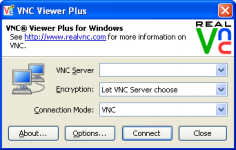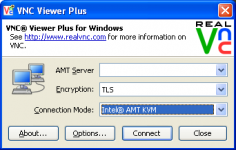 RealVNC 5.1.0
RealVNC 5.1.0
RealVNC - (Freeware)
Viewing and even controlling one remote computer from another desktop computer is possible with RealVNC which also offer the possibility to do this with computer with different platforms.
RealVNC is a VNC (Virtual Network Computing) customer developed to take control of remote computers, provided that VNC server is running on the remote machines.
User can view and use the remote server with a simple client program from any other computer in the world. One of the main advantages of Real VNC is that computers can have different platforms being possible, for example, to view and control a workstation running Linux from the personal computer with Windows.
- Title:
- RealVNC 5.1.0
- File Size:
- 11.2 MB
- Requirements:
- Windows (All Versions)
- Language:
- en-us
- License:
- Freeware
- Date Added:
- 09 Dec 2013
- Publisher:
- RealVNC
- Homepage:
- http://www.realvnc.com
- MD5 Checksum:
- 8CBAB45ACAF859B9DA672534A43543A8
# All platforms
* NEW: VNC Server can check whether critical software patches, and product updates to which you are entitled, are available to download from the RealVNC web site.
* NEW: VNC Server publishes a more-memorable catchphrase than the unique signature on which it is based, detering man-in-the-middle attacks by making identity checks more intuitive for connecting users. (Enterprise and Personal only)
* NEW: VNC applications can be configured remotely, and locked down to prevent change, using policy. Policy template files are available to download for distribution to target computers using a suitable mechanism, for example Group Policy under Windows. (Enterprise only)
* NEW: Message boxes displayed when connections are unexpectedly terminated can now be suppressed using the HideCloseAlert VNC Viewer parameter, making scripting easier.
* The VNC Server Options dialog has been made easier to use, and highlights features locked down by policy. For both VNC Server and VNC Viewer, it also simplifies the process of creating debug log files to send to RealVNC Technical Support.
* The new Permissions VNC Server parameter replaces NtLogon_Config (Windows) and AllowedUsers/AllowedGroups (other platforms). Existing users, groups, and permissions are automatically upgraded. (Enterprise and Personal only)
* The Permissions parameter now grants access to features in the following sets: f (full), d (default), v (view-only). More information. (Enterprise and Personal only)
* The Permissions parameter now supports explicitly denying permission to use a feature, as well as allowing and not allowing that feature. Deny cannot be overridden by individual members of a group. (Enterprise and Personal only)
* VNC Server logs are now directed to file at more appropriate locations, as determined by the new LogDir parameter. More information.
* The VNC Server Information Center dialog now distinguishes between successful and unsuccessful connections on the Diagnostics page, which may give warning of a port sniffing or brute-force dictionary attack.
* All instances of VNC Server running on a computer can be reconfigured without downtime using the vnclicense -reload command.
* Single sign-on authentication is now easier to set up and benefits from new documention. (Enterprise only)
* VNC parameters are now fully documented.
* FIXED: Copying and pasting text from connected computers is now more reliable. See also the ServerClipboardGraceTime VNC Viewer parameter.
# Windows
* NEW: Separate MSI installers for VNC Server and VNC Viewer are available for download for deployment to target computers in a Group Policy Object. VNC Server can also be licensed at install-time using a Group Policy transform.
* FIXED: Key combinations such as Alt+Tab are now supported for connections to Windows 8 computers. Note VNC Server must be installed to a secure location such as C:\Program Files.
* FIXED: Second and subsequent monitors plugged-in to discrete graphics cards on Windows 8 computers are now remoted to connected users.
# UNIX
* NEW: Support for Ubuntu 13.10, Debian 7 and Fedora 19.
* NEW: The RootSecurity VNC Server parameter protects the system credentials of connecting users from observation by a VNC Server owner who is not root.
* NEW: The VNC Server in Virtual Mode daemon (vncserver-virtuald) supports single sign-on authentication. (Enterprise only)
* NEW: The VNC Server in Virtual Mode user interface can be hidden using the StartUI VNC Server parameter.
* NEW: VNC Server in Virtual Mode can clean up stale sockets and release display numbers using the vncserver-virtual -clean command.
* VNC Server no longer automatically authenticates users with locked or expired accounts. (Enterprise only)
* VNC Server in Virtual Mode now creates a virtual desktop with a default color depth of 24 (32 bits-per-pixel).
* The Permissions VNC Server parameter now accepts the ID of a group as well as its name. (Enterprise and Personal only)
* Under AIX, PAM can be substituted for LAM more easily using the new UsePam VNC Server parameter.
* The vnclicense utility can manage license keys in locations other than the default /etc/vnc using the new LicenseDir VNC parameter. This is especially useful when installing on a network share.
* The man pages have been rewritten.
# Mac OS X
* VNC Server no longer automatically authenticates users with locked or expired accounts. (Enterprise only)
* VNC Server now checks groups other than the primary Active Directory group to ascertain whether connecting users are eligible to authenticate. (Enterprise and Personal only)
* The vnclicense utility can manage license keys in locations other than the default /etc/vnc using the new LicenseDir VNC parameter.
Related software
4.0/5 from 48 users


